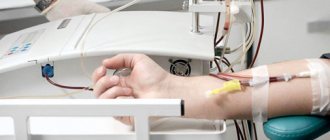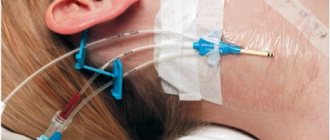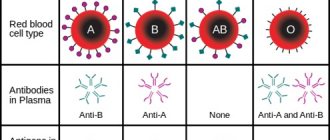Hyperemia is
The definition of Hyperemia comes from the merger of two Greek words, where “hyper” means too much, and “haima” means blood. When blood accumulates in some part of the body or near some organ, we speak of hyperemia. Externally, it manifests itself as redness of the problem area, and sometimes the body temperature may rise locally. Sometimes a rush of blood causes tissue swelling.
There are several reasons that cause hyperemia. First of all, possible pathologies of the blood supply are identified: the inflow and outflow of blood in a specific area. If there are no problems in the circulatory system, then other possible causes are determined, including:
- temperature changes;
- stress;
- hormonal disorders;
- allergic reactions;
- infectious lesion;
- burn.
It is necessary to eliminate hyperemia from the diagnosis, since it is not a disease in itself, but is considered by medicine exclusively as a symptom.
Causes of temporary facial hyperemia
- Change in body temperature.
- Strong emotional manifestations (excited state, emotional excitement).
- Increased physical activity. Mechanical influences, for example, wind, frost, friction.
- Allergic reactions.
If the causes are eliminated, temporary hyperemia goes away on its own. This is a kind of protection for the body. Increased blood circulation will allow the skin to recover soon. This hyperemia is local in nature and does not spread to the entire body.
If redness is caused by the weather - wind and cold, then the following remedies are suitable:
- Vaseline (30 g) plus anesthesin (3g);
- Vaseline (20 g) plus zinc ointment (10 g) plus salol (3 g).
With nervous excitement, calming herbs will help, for example, mint, oregano, motherwort, valerian.
Some causes of pathological skin hyperemia:
- Increased hemoglobin level or erythrocytosis.
- Feverish conditions.
- Alcohol or drug poisoning.
- Intestinal diseases - constipation, helminthic infestations, infections.
- Otolaryngological diseases: rhinitis, sinusitis.
- Osteomyelitis, anaphylaxis, diffuse toxic goiter.
- Systemic lupus erythematosus.
- Diffuse redness of the skin.
- Diseases associated with the circulatory system.
- Inflammatory processes on the skin: pimples, acne, furunculosis, wounds.
Eliminating pathological skin hyperemia is a more complex process. It is necessary to treat the concomitant disease. To do this, you need to change your lifestyle to a more correct one.
Give up bad habits, change your usual diet. Eat more fresh vegetables, fruits and herbs. The skin warns in red about a dangerous state of the body.
Types of hyperemia
Hyperemia is primarily considered as a pathology of the circulatory system. There are two types of pathological hyperemia:
- arterial;
- venous.
Arterial is called excessive blood supply to an organ when the arteries supply large volumes of blood that the venous system does not have time to remove. Arterial hyperemia can be physiological when more blood begins to flow to the organ during increased load. And venous is called hyperemia, which occurs during normal blood supply, which the venous system cannot drain due to the resulting pathology. For example, with blockage, thrombosis, or atherosclerosis, the lumen of the vascular bed is significantly reduced, and the passage of blood flow is significantly hampered.
The cause of venous hyperemia may be low blood rheology. When it is thick, it is difficult for the heart to pump it throughout the body system. In such a situation, you need to undergo an examination to confirm the problem, and in case of really thick blood, the doctor will prescribe treatment. Most often, it is enough to buy a drug that thins the blood and reduces the risk of blood clots.
The neurotonic type of hyperemia is said to occur when the tone of the nerve conductors increases under the influence of certain factors. First of all, this is facilitated by emotional activity. The second factor that increases the tone of nerve fibers is infectious diseases affecting the nervous system.
Along with an increase in the conductivity of nerve fibers, there is also a reverse reaction - a decrease in tone. As a rule, this is a temporary phenomenon caused by many reasons, such as tissue compression, swelling, hypothermia. As soon as the obstacle to the passage of arterial blood is removed, the tissues are filled with biological fluid with increased intensity, which causes the effect of hyperemia.
Hyperemia: what is it?
Hyperemia is the excessive supply of blood to the vessels of one or another part of the body (skin, organ lining).
Hyperemia: from ancient Greek. hyper - over, excessively; haima - blood).
Based on the coverage area, hyperemia is classified into focal and widespread . Focal hyperemia is a common symptom of diseases of the digestive system (stomatitis, stomach or duodenal ulcers, etc.). It looks like separate spots on certain parts of the body, most often on the skin.
Widespread hyperemia is noticeable in different parts of the body (on the skin and mucous membranes, on the membrane of the eye), and occupies a large area. It is this that is an independent syndrome.
Not only capillaries, arterioles and venules, but also large vessels - arteries and veins - can be involved in the hyperemic reaction. Depending on which vessels the process spreads through, arterial (active) and venous (passive) hyperemia .
An arterial hyperemic reaction occurs with an increase in arterial blood inflow (with normal venous outflow), and venous hyperemia is caused by impaired outflow of venous blood (with normal arterial inflow). There are very different reasons for both.
Reasons G.
Arterial hyperemia is always caused by exposure to external stimuli on the body. It can occur with strong friction, with thermal and chemical burns, with poisoning and bites of snakes and insects, with an infectious increase in body temperature, with the penetration of foreign proteins and pathological microorganisms into the body, with stress and increased heartbeat. Arterial hyperemia as a physiological reaction can be useful; it is deliberately induced by various procedures for therapeutic purposes.
At the same time, venous hyperemia occurs as a vascular response to internal problems of the body. The narrowing of the venous lumen is associated with the appearance of blood clots, scars, cysts, tumors, hernias, prolapse of internal organs, pregnancy, wearing tight clothes and shoes, and prolonged uncomfortable body position.
Symptoms G.
In the active form, in the zone of hyperemia, the lumen of the arteries is increased, redness and swelling are observed, the speed of blood flow, blood pressure and pulse in the arteries increase, lymph flow is accelerated, and the temperature is increased.
In the venous form, the affected area is enlarged in size, takes on a bluish color, and becomes colder. In this case, there is a lack of oxygen in the tissues.
Skin hyperemia is its redness in a particular area of the body. Occurs as a symptom of a disease.
When the brain is hyperemic, the mucous membranes turn red, breathing and heart rhythm are impaired.
Treatment and prevention G.
For effective treatment and prevention of hyperemia, it is important to restore normal blood circulation in large and small vessels of the affected area.
In general, hyperemia is not a disease in itself, but a symptom of another condition, usually some kind of disease of the cardiovascular system. The latter must be diagnosed and treated.
The most dangerous is venous hyperemia, especially hyperemia of the brain and its membranes. In acute cases, it can be fatal; chronic hyperemia can develop into hydrocephalus.
How can we help with G.?
First of all, manual diagnosis of the body is necessary. It will show what is the cause of problems with blood vessels. Special methods of medical massage (visceral, myofascial, segmental reflex and others), as well as the AtlasPROFessional method (medical massage C0/C1) allow you to restore and normalize lymph flow and vasomotor function of blood vessels, relieve lymphatic and venous congestion, remove the threat of compression of large vessels, eliminate prolapse of the abdominal and pelvic organs.
View on the map of Ufa Find directions to Atlant, spinal correction center
Facial hyperemia
Facial hyperemia can occur as a result of a complex of vascular problems. A similar situation occurs with high blood flow speed and increased pressure. In addition, a small difference in the oxygen content between arterial and venous blood forces the heart and lungs to work harder, which provokes redness.
After a walk in the frosty air, hyperemia also occurs. It is caused by a sharp narrowing of the thin capillaries of the facial skin in response to low temperatures, which is replaced by a sharp increase in blood flow. This is how the body understands that there are areas of the body that are not protected by clothing, which need to be ensured vitality by being warmed by the bloodstream.
But there is also other redness caused by an allergic reaction to frost. This is the body's pathological response to cold. Such redness does not go away for a long time, even after returning to a warm room. This reaction indicates a decrease in immunity and the body’s inability to protect itself from adverse external factors.
Allergic facial hyperemia can be distinguished from physiological hyperemia by several signs. For allergies:
- redness occurs on all open areas of the body;
- hyperemia may take the form of urticaria;
- skin itching appears;
- the mucous membrane swells;
- there is a flow from the nose or tear duct;
- headache appears.
The temperature rarely rises during an allergic reaction.
Hyperemia of the brain and its membranes
Hyperemia of the brain and its membranes (Hyperaemia cerebri et meningum) is a disease characterized by overflow of blood vessels in the brain in animals and dysfunction of the brain centers.
Mostly adult horses and draft animals are affected.
Etiology . There are two forms of hyperemia: active, which occurs as a result of increased blood flow to the brain, and passive, which develops when the outflow of venous blood from the brain is obstructed.
Active hyperemia develops in animals as a result of autointoxication in many infectious and non-contagious diseases, poisoning with plant or mineral poisons (atropine, amyl nitrite, etc.), overdose of certain drugs (chloral hydrate and other drugs), metabolic disorders (ketosis). Active hyperemia is also observed with increased work of the animal, sexual arousal during mating, overheating and increased intra-abdominal pressure. Animals with an unbalanced central nervous system (an unrestrained type of higher nervous activity) are more susceptible to the disease of active hyperemia.
Contributing to brain hyperemia is keeping animals in stuffy, poorly ventilated rooms and disrupted feeding schedules.
Venous hyperemia most often occurs in animals due to compression of the jugular vein by an incorrectly fitted clamp, which impedes the outflow of venous blood from the brain. Passive hyperemia develops in animals with traumatic pericarditis, tricuspid valve defects, myocarditis, exudative pleurisy, pulmonary emphysema, and extensive pneumonia.
Pathogenesis . As a result of the increased influx of arterial blood in the animal, intracranial pressure increases and the blood-brain barrier is disrupted, which leads to excessive irritation of the nerve centers and the predominance of excitation processes over inhibition. Stagnation of venous blood in the vessels of the brain quickly leads to the development of brain hypoxemia and hypoxia, excessive consumption of glucose by nerve cells, which reduces their excitability.
Clinical picture . Active hyperemia of the brain is characterized by recurring, increasing in strength symptoms, indicating excitement of the nervous system. As the process develops, excitement gives way to depression.
Animals strive to move forward uncontrollably, not paying attention to obstacles, the animal is timid, excited, cows moo, kick, butt. Reflexes are strengthened, there is an aggravated reaction to sound stimuli, and photophobia. On palpation, the skull and base of the horns are hot to the touch. The conjunctiva is hyperemic. The pupils are dilated (constricted when depressed). The heartbeat is pounding, the pulse is large, the pulse wave is large, the second tone is intensified.
Breathing is rapid, shallow, and in severe cases arrhythmic. Appetite is reduced or absent, and cattle do not chew cud. The motility of the rumen is weakened. Diuresis is reduced. The body temperature of a sick animal may be elevated or normal.
Passive hyperemia of the brain is characterized by depression, apathy, drowsiness, weakening of superficial skin reflexes and strengthening of deep and tendon reflexes, shaky and uncertain gait, cyanosis of visible mucous membranes, difficulty breathing, rapid pulse of small filling in the absence of elevated body temperature. Cattle may develop tympany of the proventriculus. Sheep with brain hyperemia tend to move straight or in a circle, shake their heads, hold them askew, and fall. Dogs, when sick, bark for no reason, squeal, try to bite and run away, grab air with their teeth, and have the urge to vomit. In mild cases of the disease, general cerebral symptoms may be absent, but as hyperemia increases, they may gradually increase.
The prognosis for primary arterial hyperemia of the brain is usually favorable. Venous hyperemia, with timely provision of medical care, results in a quick recovery. In cases where the causes of blood stagnation in the vessels of the brain cannot be eliminated, the prognosis for the disease worsens. Venous hyperemia complicates the course of the underlying disease. Leading in acute cases to death, and in chronic cases to the development of hydrocephalus.
Pathoanatomical changes in arterial hyperemia are characterized by increased injection of arterial vessels, the gray and white matter of the brain is reddish in color, and large quantities of bright red arterial blood appear on the section. With venous hyperemia, we note that the venous vessels of the meninges are overfilled with venous blood, the medulla is swollen, drops of dark red venous blood are visible on the section, the cerebral ventricles are overfilled with cerebrospinal fluid.
The diagnosis is made based on the history and symptoms of the disease. Brain hyperemia is characterized by general cerebral symptoms in the absence of focal symptoms and movement disorders, as well as the detection of a congestive nipple and hyperemia of the fundus of the eye during ophthalmoscopy.
Differential diagnosis . In the differential diagnosis, inflammation of the brain and its membranes, heat and sunstroke, infectious diseases (rabies, Aujeszky's disease, anthrax, tuberculous meningitis, malignant catarrhal fever), cerebral coenurosis are excluded, which are excluded on the basis of anamnestic data, clinical picture and epizootic situation .
Treatment . Treatment of a sick animal should be aimed at eliminating the cause of brain hyperemia. The sick animal is transferred to a cool, well-ventilated, darkened and noise-free room. If cerebral hyperemia occurs under the influence of easily eliminated causes (incorrectly fitted harness, etc.), then the disease quickly resolves after eliminating the etiological factor and giving the sick animal rest, even without the use of special therapeutic measures.
In severe forms, animal owners must take measures to prevent self-harm of the animal and injury to staff by isolating the animal in a dark, well-ventilated room with soft bedding. In case of active hyperemia, a cold compress or rubber bag with ice is placed on the scalp area. At the beginning of the disease, when there is excitement, bloodletting is indicated (up to 4l), however, with the development of depression and with passive hyperemia of the brain, bloodletting is contraindicated. To reduce agitation and irritation, aminazine is administered intramuscularly, chloral hydrate and sodium bromide are administered intravenously. Magnesium sulfate is injected intramuscularly. For small animals with strong excitement, Bromural, Medinal, Veronal, and Luminal are given orally. In the early stages of active hyperemia, bloodletting in moderate doses is useful. For venous hyperemia, caffeine, cordiamine, digitalis preparations, and lobeline are used to increase the tone of the heart muscle and activate blood circulation.
For treatment, dehydration agents (hypothiazide, mannitol, diacarb) are used. In order to improve microcirculation and reduce the yield of blood cells, parmidine, acetylsalicylic acid, and rheopolyglucin are used.
Prevention is based on compliance with zoohygienic rules for keeping and exploiting animals, carrying out general and special preventive measures, as well as timely identification and treatment of sick animals.








